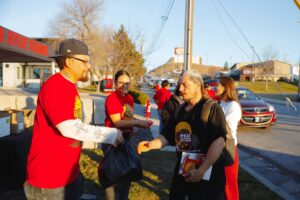
April 3, 2015; WDIV – Click on Detroit
Last month, as he was taking out the garbage, Federal Judge Terrence Berg was accosted in a robbery attempt and shot in the leg. It was one reminder that Detroit’s neighborhoods, the linchpin of the city’s ultimate revival, are still in the process of coming back, with the endpoint a long way away.
Detroit’s neighborhoods remain the ultimate challenge in bringing the Motor City back from the depths of bankruptcy. After bailing out the city’s pension shortfalls through the artifice of saving the collection of Detroit Institute of Art from the auction block, Detroit’s foundations have a challenge—what are they going to do for the people of Detroit, the neighborhood residents who have done their best to hold things together while powerful interests disinvested from the city and more affluent residents high-tailed it for the suburbs?
Last week, the Kresge Foundation (Full Disclosure: Kresge has been a funder of Nonprofit Quarterly) announced $1.6 million in grants for 18 neighborhood projects, the first phase in a planned $5 million, three-year initiative. Eleven of the grants, running between $100,000 and $150,000, are for “shovel-ready” projects, to include the following:
Sign up for our free newsletters
Subscribe to NPQ's newsletters to have our top stories delivered directly to your inbox.
By signing up, you agree to our privacy policy and terms of use, and to receive messages from NPQ and our partners.
- Converting some vacant lots in the North Corktown and Briggs neighborhoods into pocket parks
- Developing a market garden, nutrition programs, and an education center in Chaldean Town
- Converting the vacant St. Anthony Lithuanian Church in Southwest Detroit into a community center
- Supporting a neighborhood stabilization program in the Osborn neighborhood
Grants of $20,000 to $25,000 were dedicated to planning functions for another half-dozen neighborhood projects.
A few days before the Kresge news, the Knight Foundation announced that six Detroit projects would be sharing in approximately $600,000 for innovative projects, such as Claire Nelson’s proposed “consulate where city dwellers and travelers can have a cross-city cultural exchange” (she described it as “more like a living room, a salon, where you can have intimate spaces and conversations”); something called “Detroit’s Neighborhood Initiative, The RE-Effect,” sponsored by “Brand Camp University” to change “the narrative of underserved neighborhoods by developing compelling branding and digital presences for neighborhood businesses that better tell their stories”; and “the Buzz,” which will link “barbers with landscape contractors to transform overgrown vacant lots through facilitated design workshops that teach mowing and pattern-making techniques.”
While the Kresge and Knight projects may well turn out to be useful, something about the list of grants, Kresge’s list of traditional neighborhood development initiatives and Knight’s much more kitschy selections, feels short of the mark. The bankruptcy and the DIA mobilized foundations of all sorts to come together with an unprecedented multi-year funding commitment. The City’s education problems, which we described in an article last week, have the Skillman Foundation taking a vigorous leading role, even if the strategies seem to be leaning toward privatization strategies, which seem to be an all too familiar result for foundations leaning toward what they hope will be quick fixes for schools.
For the neighborhoods per se, there is a Detroit City Plan that was generated with Kresge leadership. However, to implement that plan—assuming the $1.6 million in Kresge grants and the $600,000 in Knight grants fit into that strategy—it seems like something of a Marshall Fund for Detroit’s neighborhoods is needed. Is philanthropy going to step up? We’ll sit in on the Detroit panel at the upcoming Council on Foundations annual meeting to see what the answer might be.—Rick Cohen











